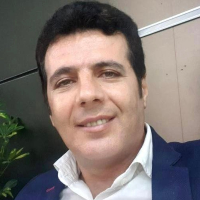فهرست مطالب نویسنده:
p. mohebbi
-
In this paper a hybrid approach of Sequential Gaussian Simulation (SGSIM) and Concentration-Volume (C-V) fractal method was applied to boreholes data for classification of major geochemical parameters and associated features with alteration zones of the Haftcheshmeh Cu deposit in NW of Iran. Thereupon, Cu parameters were detected with higher efficiency and lower uncertainty. The purpose is also extended to delineate the alteration zones pertinent to Cu mineralization. Firstly, the most straightforward simulation (SGSIM) was utilized for projecting different lithogeochemical parameters of Cu. Then the C-V fractal model was used to discriminate these parameters by thresholds, obtained from the C-V Log-Log plot. The Fractal based resulting maps of 10 realizations and their E-type indicate their association with potassic alteration that has imposed on porphyry granodiorite. Moreover, these maps illustrate that the boreholes (1, 9, 23, and 31) at about longitudes of 643400 to 643800 are more promising than others. This fact explicitly had been correlated with reality of the studied area and denoted in its primary surface map. The results based on SGSIM, C-V confirmed enhanced mineralization in three-dimensional maps of the Haftcheshmeh deposit as a powerful combined method that can be used to detect the similar ore zones in continuation of the ore roots in adjacent areas.Keywords: Sequential Gaussian Simulation, (C-V) Fractal, Cu geochemical potential mapping, Alterations, Haftcheshmeh, Iran
-
Since most of the geochemical data analysis procedures require preliminary assumptions that lead to constraint and errors in the true nature of the data causing reduction in the effectiveness of the adopted methods. Therefore, a model-based clustering method as self-organizing map (SOM) were employed with the aim of recognizing Cu-Au mineralized zones by establishing an optimized exploration tool in Valezir area, NW of Iran. SOM as a dimension reduction method was introduced to recognize geochemical distribution patterns of Cu-Au with higher certainty while preserving the originality of the data. Subsequent to data preprocessing and testing different SOM architectures, an appropriate structure with a pattern containing six clusters was selected. Accordingly, the related elements distribution model was extracted and interpretation of the geochemical system represents two significant sets of elements in clusters (i.e. 1st, 2nd and 6th clusters) to anticipate the mechanism of distribution: 1- Copper and pertaining trace elements formation from intermediate to acidic hydrothermal solutions, which are localized in the northern part of the area and emplaced in the quartz monzo-dioritd intrusive body. 2- Au Anomalies and its associated elements As, Hg and Bi depicted in 2nd cluster. The Au anomalies follow geochemical pattern with Bi, Sb, As, and W that are mostly elongated from NW to SW of the area. It seems relatively the low enrichment of gold has occurred during the intrusion of the igneous body into older volcanic units that caused extensive alterations, remobilization and localization of Au and related elements. To assess the SOM results, a comparative study was carried out with the results obtained from hierarchical clustering analysis (HCA). The results illustrated higher performance by SOM approach in characterizing geochemical system and detecting the elements paragenetic sequence in the area for locating the exploration targets.Keywords: geochemical system modeling, pattern recognition, Self-Organizing Maps (SOMs), Valezir area, NW of Iran
-
Background and AimThe Gow-Gates (GG) block and the inferior alveolar nerve block (IANB) can be used interchangeably for anesthetizing mandibular molars. The aim of this study was to compare these two injections in root canal therapy of mandibular molars with regard to heart rate (HR) and blood oxygen saturation (BOS) changes.Materials and MethodsThirty patients between the ages of 18-70 years having mandibular molars on both sides of their jaw and in need of root canal therapy were recruited after signing a consent form. The patients' HR and BOS were measured 5 minutes before and immediately, 2, 5, 10, 15, and 20 minutes after injection by using a pulse oximeter. Paired t-test and Friedman test were used for statistical analysis of the data.ResultsThis study was done on 30 patients (60 teeth). The results of HR and BOS showed no significant differences between the two injection techniques (P=0.6 and 0.7, respectively). Also, HR and BOS in each group were not significantly changed during the follow-ups (P=0.7 and 0.6, respectively).ConclusionAccording to the results, IANB and GG block by using 2% lidocaine and 1:80000 epinephrine had no significant different effects on HR and BOS.Keywords: Heart rate, Oximetry, Inferior alveolar nerve, Local anesthesia, Lidocaine
سامانه نویسندگان
اطلاعات نویسنده(گان) توسط ایشان ثبت و تکمیل شدهاست. برای مشاهده مشخصات و فهرست همه مطالب، صفحه رزومه ایشان را ببینید.
بدانید!
- در این صفحه نام مورد نظر در اسامی نویسندگان مقالات جستجو میشود. ممکن است نتایج شامل مطالب نویسندگان هم نام و حتی در رشتههای مختلف باشد.
- همه مقالات ترجمه فارسی یا انگلیسی ندارند پس ممکن است مقالاتی باشند که نام نویسنده مورد نظر شما به صورت معادل فارسی یا انگلیسی آن درج شده باشد. در صفحه جستجوی پیشرفته میتوانید همزمان نام فارسی و انگلیسی نویسنده را درج نمایید.
- در صورتی که میخواهید جستجو را با شرایط متفاوت تکرار کنید به صفحه جستجوی پیشرفته مطالب نشریات مراجعه کنید.


